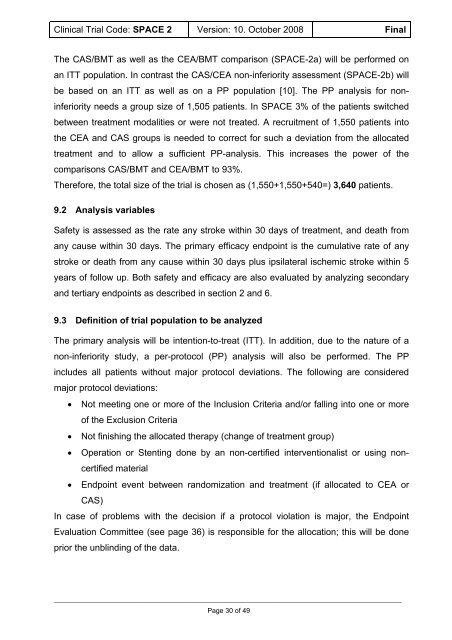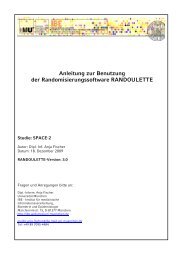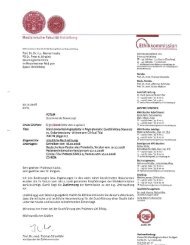CLINICAL TRIAL PROTOCOL SPACE 2 Stent ... - SPACE-2 Studie
CLINICAL TRIAL PROTOCOL SPACE 2 Stent ... - SPACE-2 Studie
CLINICAL TRIAL PROTOCOL SPACE 2 Stent ... - SPACE-2 Studie
Create successful ePaper yourself
Turn your PDF publications into a flip-book with our unique Google optimized e-Paper software.
Clinical Trial Code: <strong>SPACE</strong> 2 Version: 10. October 2008 Final<br />
The CAS/BMT as well as the CEA/BMT comparison (<strong>SPACE</strong>-2a) will be performed on<br />
an ITT population. In contrast the CAS/CEA non-inferiority assessment (<strong>SPACE</strong>-2b) will<br />
be based on an ITT as well as on a PP population [10]. The PP analysis for noninferiority<br />
needs a group size of 1,505 patients. In <strong>SPACE</strong> 3% of the patients switched<br />
between treatment modalities or were not treated. A recruitment of 1,550 patients into<br />
the CEA and CAS groups is needed to correct for such a deviation from the allocated<br />
treatment and to allow a sufficient PP-analysis. This increases the power of the<br />
comparisons CAS/BMT and CEA/BMT to 93%.<br />
Therefore, the total size of the trial is chosen as (1,550+1,550+540=) 3,640 patients.<br />
9.2 Analysis variables<br />
Safety is assessed as the rate any stroke within 30 days of treatment, and death from<br />
any cause within 30 days. The primary efficacy endpoint is the cumulative rate of any<br />
stroke or death from any cause within 30 days plus ipsilateral ischemic stroke within 5<br />
years of follow up. Both safety and efficacy are also evaluated by analyzing secondary<br />
and tertiary endpoints as described in section 2 and 6.<br />
9.3 Definition of trial population to be analyzed<br />
The primary analysis will be intention-to-treat (ITT). In addition, due to the nature of a<br />
non-inferiority study, a per-protocol (PP) analysis will also be performed. The PP<br />
includes all patients without major protocol deviations. The following are considered<br />
major protocol deviations:<br />
• Not meeting one or more of the Inclusion Criteria and/or falling into one or more<br />
of the Exclusion Criteria<br />
• Not finishing the allocated therapy (change of treatment group)<br />
• Operation or <strong>Stent</strong>ing done by an non-certified interventionalist or using noncertified<br />
material<br />
• Endpoint event between randomization and treatment (if allocated to CEA or<br />
CAS)<br />
In case of problems with the decision if a protocol violation is major, the Endpoint<br />
Evaluation Committee (see page 36) is responsible for the allocation; this will be done<br />
prior the unblinding of the data.<br />
_______________________________________________________________________________________________________<br />
Page 30 of 49





